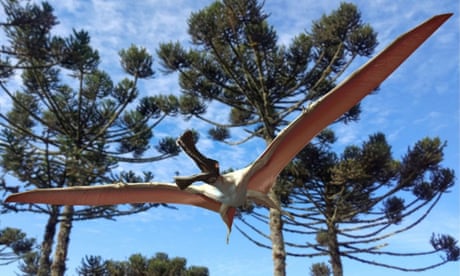FROM THE MUSEUM STORAGE ROOM
Giant flying reptiles revealed to have soared Australia’s skies 107m years ago
Fossils discovered in Victoria 30 years ago are of pterosaurs, the earliest known vertebrates to evolve true flight
Donna Lu
Science writer
THE GUARDIAN AUSTRALIA
THE GUARDIAN AUSTRALIA
Tue 30 May 2023
The oldest flying reptiles in Australia soared in the skies around 107m years ago, researchers have confirmed after examining fossils.
Palaeontologists have analysed bone specimens belonging to two separate pterosaurs – winged reptiles that were the earliest vertebrates to evolve true flight – which were originally discovered more than 30 years ago.

Fossilised partial skeleton of new flying reptile species found in Queensland
One specimen, a small wing bone, belonged to a juvenile pterosaur – the first ever reported in Australia. The other, a partial pelvic bone, came from a pterosaur with a wingspan exceeding 2 metres. They date to 107m years ago.
The bones were first discovered in the 1980s at Dinosaur Cove near Cape Otway in southern Victoria, by a team led by the Museums Victoria Research Institute’s Dr Tom Rich and Prof Pat Vickers-Rich.
Until now, they had never been described in peer-reviewed scientific research, which has been published in the journal Historical Biology.
The study’s lead author, Adele Pentland of Curtin University, said pterosaurs are known to have existed on every continent, including Antarctica.
Though both prehistoric and reptilian, pterosaurs are distinct from flying dinosaurs.
Pentland is completing a PhD in pterosaurs and in 2019 named a new species of the reptile, Ferrodraco lentoni, which was also the most complete Australian pterosaur found to date.
Pentland was unable to determine what exact species the two Cape Otway pterosaurs specimens are. Unusually, they were found a “high paleolatitude” site.

The oldest flying reptiles in Australia soared in the skies around 107m years ago, researchers have confirmed after examining fossils.
Palaeontologists have analysed bone specimens belonging to two separate pterosaurs – winged reptiles that were the earliest vertebrates to evolve true flight – which were originally discovered more than 30 years ago.

Fossilised partial skeleton of new flying reptile species found in Queensland
One specimen, a small wing bone, belonged to a juvenile pterosaur – the first ever reported in Australia. The other, a partial pelvic bone, came from a pterosaur with a wingspan exceeding 2 metres. They date to 107m years ago.
The bones were first discovered in the 1980s at Dinosaur Cove near Cape Otway in southern Victoria, by a team led by the Museums Victoria Research Institute’s Dr Tom Rich and Prof Pat Vickers-Rich.
Until now, they had never been described in peer-reviewed scientific research, which has been published in the journal Historical Biology.
The study’s lead author, Adele Pentland of Curtin University, said pterosaurs are known to have existed on every continent, including Antarctica.
Though both prehistoric and reptilian, pterosaurs are distinct from flying dinosaurs.
Pentland is completing a PhD in pterosaurs and in 2019 named a new species of the reptile, Ferrodraco lentoni, which was also the most complete Australian pterosaur found to date.
Pentland was unable to determine what exact species the two Cape Otway pterosaurs specimens are. Unusually, they were found a “high paleolatitude” site.

Prof Pat Vickers-Rich and Dr Tom Rich showing the pterosaur bone specimens they discovered in the 1980s. Photograph: Museums Victoria
“Back when [these pterosaurs] were alive, Australia was part of the big southern continent Gondwana,” Pentland said. “Victoria was much farther south than it is today and was in the polar circle.
“Sedimentary geology is telling us that these animals potentially lived in darkness for weeks, if not months, throughout the year. It would be great to answer in the future … did pterosaurs tough it out in these harsh conditions, were they permanent year-round residents, or could they migrate? We don’t know.”
Four pterosaur species have been described in Australia to date, based on fossils found in central western Queensland.
“In terms of the Australian pterosaur record, we have a bit of catching up to do,” Pentland said. “The first pterosaurs were described in the 18th century, but here in Australia, the first pterosaur bones weren’t published in a scientific journal until 1980.”
“Back when [these pterosaurs] were alive, Australia was part of the big southern continent Gondwana,” Pentland said. “Victoria was much farther south than it is today and was in the polar circle.
“Sedimentary geology is telling us that these animals potentially lived in darkness for weeks, if not months, throughout the year. It would be great to answer in the future … did pterosaurs tough it out in these harsh conditions, were they permanent year-round residents, or could they migrate? We don’t know.”
Four pterosaur species have been described in Australia to date, based on fossils found in central western Queensland.
“In terms of the Australian pterosaur record, we have a bit of catching up to do,” Pentland said. “The first pterosaurs were described in the 18th century, but here in Australia, the first pterosaur bones weren’t published in a scientific journal until 1980.”
No comments:
Post a Comment